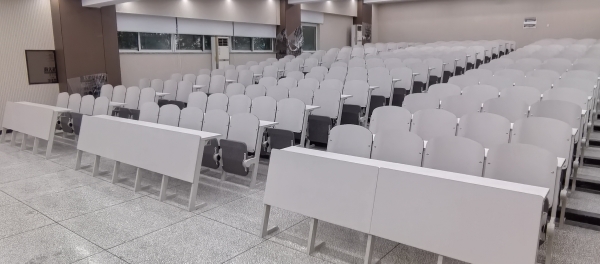In universities, training institutions, lecture halls, and other venues, university fixed seatings are large-volume, long-term fixed assets. When purchasing, many decision-makers often focus solely on the price of the university fixed seatings, overlooking their long-term maintenance costs. In reality, over the course of 5-10 years, the cost of ongoing maintenance and the frequency of replacements often determine the overall investment more than the initial purchase cost.
So, when purchasing a university fixed seating, how can you scientifically assess long-term maintenance costs?
1. Material and structure determine the lifespan of a university fixed seating.
a. Frame material
High-quality university fixed seatings often use thickened steel frames that are spray-coated or electroplated for corrosion and rust resistance, reducing replacement costs due to structural damage.
If low-cost, ordinary steel is purchased, problems such as loose welds and frame deformation may occur within 2-3 years.
b. Seat fabric
Fabric university fixed seatings: While comfortable, they are difficult to clean and maintain, requiring regular seat replacement.
Fireproof leather university fixed seatings: More suitable for lecture hall and high-use lecture theatre chairs, they facilitate cleaning and disinfection, reducing maintenance costs.
c. Functional Configuration
university fixed seatings with tablets: Pay attention to the tablet's hardware and folding mechanism. Low-quality components can easily damage, increasing the need for subsequent repairs.
2. Frequency of Use and Scenario Affect Maintenance Intensity
a. University Classrooms: Students use the chair frequently daily, placing the greatest strain on the chair's lifespan. Durable and wear-resistant university fixed seatings should be prioritized.
b. Multi-purpose Lecture Halls: Less frequently used, but with higher demands on appearance and comfort, maintenance focuses on regular cleaning and maintaining the appearance.
c. Training Centers/Examination Rooms: Compact seating is required to save space. In these scenarios, neglecting material quality often leads to a high rate of damage.
Therefore, before purchasing, consider the scenario's needs and estimate the lifespan and maintenance costs of the university fixed seating.

3. What are the main components of maintenance costs?
a. Daily Cleaning Costs
Easy-to-clean leather or stain-resistant fabrics can significantly reduce labor and material costs.
b. Parts Replacement Costs
Writing boards, armrests, and seat cushions are the most vulnerable components. If the manufacturer provides standardized parts, later replacement costs will be lower.
c. After-Sales Service and Warranty
When purchasing, focus on whether the manufacturer of the university fixed seating offers a long-term warranty and spare parts supply to avoid having to replace the entire row due to unrepairable equipment.
4. How to Reduce Long-Term Maintenance Costs?
Prioritize Quality: Don't just compare university fixed seatings by price; also compare their lifespan, ease of maintenance, and after-sales service.
Choose an experienced manufacturer: university fixed seating manufacturers with university project experience understand the challenges of long-term use.
Focus on Sustainable Design: Modular classroom chairs allow for individual component replacement, reducing overall maintenance costs.
Pre-budget Planning: During the procurement phase, it is recommended to factor in the five-year maintenance cost of the university fixed seating into your overall investment assessment, rather than just the one-time purchase cost.
Navigation
Contact Us
0086 13927706942
0757-86513332
Huangji Road, Jiujiang Nanhai, Foshan, Guangdong, China
Leaving a message. :